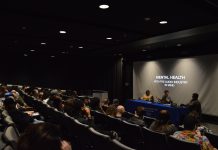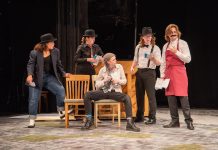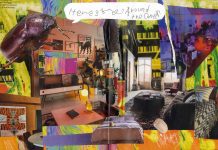
Dressed in their black and white habits, Sister Antona Ebo of the St. Mary Franciscan order and Sister Ann Christopher of the Loretto order in St. Louis walked into Selma, Alabama knowing the threats that lay ahead of them.
Tear gas, beatings and murder were a few of the consequences they, along with four other nuns, risked during three civil rights marches from Selma to Montgomery in 1965.
They arrived on March 9, two days after the first march, “Bloody Sunday.” The sisters arrived the day a white minister, who supported the marches, was chased and murdered.
Ebo was the only black nun marching.
“If people were willing to do that to a white man, what more would they be willing to do to me?” Ebo, 86, said.
However, Ebo said fear was not going to stop her from marching.
“I really believe in justice,” Ebo said. “When something happens like this, I can’t ignore it.”
Christopher heard about the outbreak of violence in Selma and a group of priests that were going there to assist the people and activists such as Martin Luther King Jr. She asked Father John Shocklee, the head of the St. Louis parish, if she could also march.

Christopher was living in an inner city apartment with some of her students while she taught undergraduate sociology at Loretto College in St. Louis. The neighborhood she lived in was a primarily black community. Christopher said she eventually felt like she became a part of the neighborhood.
“I said that I would really like to go and represent the neighborhood I lived in,” Christopher said. “I knew that they (neighbors and roommates) were not able to go, so I went on behalf of them. They supported me going and really believed in Dr. King’s message. I was in the same spirit with them, but I knew we would keep going even if the march didn’t work.”
She said the reason she went to Selma was because she truly believed that every person of any race was her equal. She also felt that if she truly was going to make a difference to the people she slept next to every night, she needed to physically be there.
“Our bodies were on the line, not just our voices,” Christopher said. “We didn’t just ‘talk-the-talk.’ ”
Growing up, her father was a butcher who had black co-workers. Her mother, a factory worker, had a black boss. Christopher said there were no cruel words said about other races in her house while she was a child. One evening, her mother’s boss invited the family over for dinner. She remembers the night being very fun and that everyone had a peaceful time together enjoying good food and conversation like “normal” people do. This night, along with the beliefs she was raised with, founded her view of other races.
Christopher received permission from Father Shocklee, who asked permission from Cardinal Joseph E. Ritter for Christopher to march. She would not be going alone. Along with fellow Loretto sister, Sister Christine Mary, four nuns from different orders would join her. According to PBS’ “Sisters of Selma” documentary, these six women were the first nuns to be involved in these marches.

Hundreds of people marched across the Edmund Pettus Bridge. State troopers met them and demanded they turn around and go home. When the leaders of Bloody Sunday’s march respectfully rejected their demand, the troopers began to beat the marchers and fire tear gas. Dozens were hospitalized and the media covered it for the nation to see.
“Sure, you have a little bit of fear, because you don’t know what’s going to happen,” Christopher said. “It’s the fear of the unknown.”
Bloody Sunday’s events put fear in the hearts of all the sisters.
Sister Antona Ebo’s fear was more intense than it was for the other sisters.
“I knew that if we were arrested, I would get separated from the other sisters, in a different jail since I’m black,” Ebo said. “Who knows what else would have happened to me.”
With people still injured from Bloody Sunday, the sisters marched with the crowd alongside Martin Luther King Jr. on March 9 and were again faced with state troopers. The protesters tried to attain a court order that would allow them to march without interference. However, Federal District Court Judge Frank Johnson issued a restraining order saying the protesters, now numbering in the thousands, could only march to the bridge where Bloody Sunday took place until he could have additional hearings.
While marching, only two days after the horrific events of March 9, the people kept strong, Christopher said.
“There wasn’t any fear among the people,” Christopher said. “We stood in front of troopers with gas masks, but no one seemed afraid. We wanted to do whatever we could to make this right. If they wanted to throw tear gas in the crowd, so be it.”
The violence was avoided as the crowd turned back at the bridge. The Loretto sisters left after the second march and wearily returned to St. Louis.
“Some people ask why I left after only one march,” Christopher said. “But I felt that my march was a gateway for other marches to come.”
The third and last march led the protesters to Montgomery where King made his famous speech “How Long, Not Long.” According to the Dirksen Congressional center, former President Lyndon B. Johnson presented a bill to congress after watching these events unfold, which later passed as the Voting Rights Act. Thousands of black people now had the chance to vote.
Christopher said the sisters went back to their orders thinking they didn’t make a big impact. The day after she arrived back home, she taught her class and went back to everyday living.
“In a way, we didn’t feel like we did anything,” Christopher said. “But, looking back, I think we did.”
Ebo said she didn’t think that she would be doing much talking in Selma, but being the only black nun there, she attracted the media and their endless questions.
“I just went to walk, not to talk,” Ebo said.
However, when she did speak, her words inspired others to have the courage to vote.
“I am here because I am a Negro, a nun, a Catholic, and because I want to bear witness,” said Ebo.



